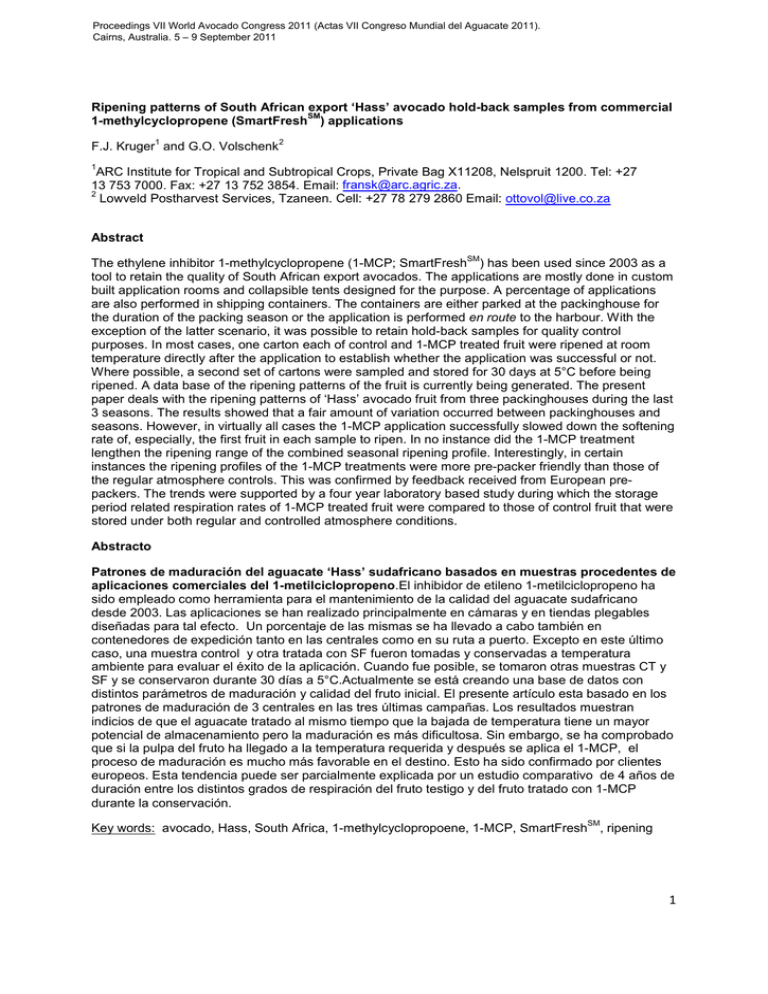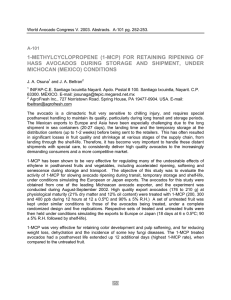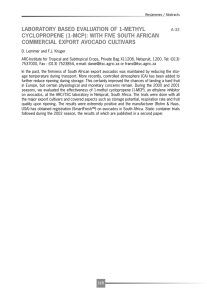Proceedings VII World Avocado Congress 2011 (Actas VII Congreso Mundial... Cairns, Australia. 5 – 9 September 2011
advertisement

Proceedings VII World Avocado Congress 2011 (Actas VII Congreso Mundial del Aguacate 2011). Cairns, Australia. 5 – 9 September 2011 Ripening patterns of South African export ‘Hass’ avocado hold-back samples from commercial SM 1-methylcyclopropene (SmartFresh ) applications 1 F.J. Kruger and G.O. Volschenk 2 1 ARC Institute for Tropical and Subtropical Crops, Private Bag X11208, Nelspruit 1200. Tel: +27 13 753 7000. Fax: +27 13 752 3854. Email: fransk@arc.agric.za. 2 Lowveld Postharvest Services, Tzaneen. Cell: +27 78 279 2860 Email: ottovol@live.co.za Abstract SM The ethylene inhibitor 1-methylcyclopropene (1-MCP; SmartFresh ) has been used since 2003 as a tool to retain the quality of South African export avocados. The applications are mostly done in custom built application rooms and collapsible tents designed for the purpose. A percentage of applications are also performed in shipping containers. The containers are either parked at the packinghouse for the duration of the packing season or the application is performed en route to the harbour. With the exception of the latter scenario, it was possible to retain hold-back samples for quality control purposes. In most cases, one carton each of control and 1-MCP treated fruit were ripened at room temperature directly after the application to establish whether the application was successful or not. Where possible, a second set of cartons were sampled and stored for 30 days at 5°C before being ripened. A data base of the ripening patterns of the fruit is currently being generated. The present paper deals with the ripening patterns of ‘Hass’ avocado fruit from three packinghouses during the last 3 seasons. The results showed that a fair amount of variation occurred between packinghouses and seasons. However, in virtually all cases the 1-MCP application successfully slowed down the softening rate of, especially, the first fruit in each sample to ripen. In no instance did the 1-MCP treatment lengthen the ripening range of the combined seasonal ripening profile. Interestingly, in certain instances the ripening profiles of the 1-MCP treatments were more pre-packer friendly than those of the regular atmosphere controls. This was confirmed by feedback received from European prepackers. The trends were supported by a four year laboratory based study during which the storage period related respiration rates of 1-MCP treated fruit were compared to those of control fruit that were stored under both regular and controlled atmosphere conditions. Abstracto Patrones de maduración del aguacate ‘Hass’ sudafricano basados en muestras procedentes de aplicaciones comerciales del 1-metilciclopropeno.El inhibidor de etileno 1-metilciclopropeno ha sido empleado como herramienta para el mantenimiento de la calidad del aguacate sudafricano desde 2003. Las aplicaciones se han realizado principalmente en cámaras y en tiendas plegables diseñadas para tal efecto. Un porcentaje de las mismas se ha llevado a cabo también en contenedores de expedición tanto en las centrales como en su ruta a puerto. Excepto en este último caso, una muestra control y otra tratada con SF fueron tomadas y conservadas a temperatura ambiente para evaluar el éxito de la aplicación. Cuando fue posible, se tomaron otras muestras CT y SF y se conservaron durante 30 días a 5°C.Actualmente se está creando una base de datos con distintos parámetros de maduración y calidad del fruto inicial. El presente artículo esta basado en los patrones de maduración de 3 centrales en las tres últimas campañas. Los resultados muestran indicios de que el aguacate tratado al mismo tiempo que la bajada de temperatura tiene un mayor potencial de almacenamiento pero la maduración es más dificultosa. Sin embargo, se ha comprobado que si la pulpa del fruto ha llegado a la temperatura requerida y después se aplica el 1-MCP, el proceso de maduración es mucho más favorable en el destino. Esto ha sido confirmado por clientes europeos. Esta tendencia puede ser parcialmente explicada por un estudio comparativo de 4 años de duración entre los distintos grados de respiración del fruto testigo y del fruto tratado con 1-MCP durante la conservación. SM Key words: avocado, Hass, South Africa, 1-methylcyclopropoene, 1-MCP, SmartFresh , ripening 1 Introduction SM The plant growth regulator 1-methylcyclopropene (1-MCP; SmartFresh ) has been registered in 2002 for use by South African avocado growers and the first commercial applications took place during 2003. The 1-MCP applications are primarily used to reduce the risk that ripening may take place during transport and to prevent the subsequent ‘soft landings’ that occur in the country of import. It is also used to reduce the incidence of ethylene associated physiological disorders, primarily diffuse mesocarp discolouration also known as greypulp or internal chilling injury. An account of the research and development process that took place between 2000 and 2010 was compiled by Kruger & Lemmer (2011). Interestingly, recent observations seem to indicate that 1-MCP may also reduce the incidence of fungal infections that develop due to premature softening during transport (Lemmer & Kruger, 2010). During the developmental years, 1-MCP was primarily applied to green skin cultivars such as ‘Fuerte’, ‘Pinkerton’, ‘Edranol’ and ‘Ryan’ and only a limited number of applications were made to ‘Hass’ fruit destined for ripening programmes. The reason for this was that exporters were concerned that the fruit may not ripen properly when introduced to ripening programmes. This was a valid complaint since certain ripeners did experience problems with the ripening of fruit treated with 1-MCP. Subsequent research conducted on the topic has shown that the problem may be alleviated by firstly ensuring that the fruit are cooled down to holding temperature before applying the 1-MCP and secondly that the fruit be kept under storage for 4 weeks or longer before being ripened (Roets et al., 2009). Commercial trials have also shown that 1-MCP treated fruit stored under these conditions have very similar ripening profiles to fruit stored under controlled atmosphere. (Harkema et al., 2005, Kruger & Lemmer, 2007). Currently, 1-MCP applications are performed in custom built application rooms, stationary containers, collapsible tents and mobile containers en route to the harbour. With the exception of the last option, it is possible to retain hold back samples for quality control purposes. The present paper deals with the ripening patterns of ‘Hass’ fruit samples retained at three packinghouses during the 2008 - 2010 seasons. Materials and methods The first packinghouse from which samples were obtained is located in the Tzaneen area of the Limpopo Province. Three years’ data (2008-2010) are reported on. During the 2008 season, one control and one treated carton each from 48 applications were sampled. During that particular season, all the samples were stored for 30 days at the packinghouse in a cold room set at 5°C, before being ripened at room temperature. During 2009, the number of sample cartons was increased to four (2 controls and 2 treatments). Twenty eight sets of samples were directly ripened and on 25 dates an additional 2 cartons were stored for 30 days before being ripened. During 2010, 56 sets of samples were directly ripened and 53 were stored for 30 days before being ripened. SM During each application, the service provider applied the SmartFresh at the manufacturer’s (Agrofresh, Philadelphia PA ) prescribed application rate for a 16 hour period. Before the application was done, the pulp temperature of one fruit in each pallet was measured to ensure that the consignment was within specification. The results obtained from the above packinghouse constitute the main portion of this report. Mention is also made of a set of directly ripened samples obtained from two packinghouses in a second production area (Kiepersol, Mpumalanga Province). Forty one samples from the first packinghouse and 15 from the second were directly ripened during the 2010 season. The pulp temperature was not monitored during application at these packinghouses and ripening was also done at room temperature. Processing of the data involved determining the mean number of days required to ripen each sample (M-DTR). The mean number of days required to ripen the first (F-DTR) and last (L-DTR) fruit in each sample was also determined. Most importantly, the mean standard deviation (M-STD) was calculated 2 to serve as indicator of the ripening related variation that occurred in each data set. Statistical significance was determined by means of Student T tests. In addition to the latter calculations, distribution graphs, depicting the percentage of fruit that ripened on each day during the ripening period were also compiled. Results and discussion The mean M-DTR, F-DTR, L-DTR and M-STD readings are shown in Tables 1 to 4 respectively, while the ripening profiles are visually portrayed in Figures 1 to 7. At the two Kiepersol packinghouses, the M-DTR (Table 1), F-DTR (Table 2) and L-DTR (Table 3) readings of the directly ripened 1-MCP treatments were generally 3 to 4 days longer than those or the RA treatments. In contrast, the M-STD values (Table 4) did not significantly differ. From a commercial point of view this implies that the 1-MCP application successfully contributed towards reducing the risk of soft landings without increasing the inter-fruit ripening variability. This deduction is supported by the visual ripening profile depictions (Figures 1 and 2) that show staggered distribution curves with comparable heights and base dimensions. When comparing the directly ripened M-DTR values of the control RA fruit from the Kiepersol and Tzaneen areas (Table 1), it is clear that the Kiepersol avocado fruit took approximately 4-6 days longer to ripen than the Tzaneen fruit. However, when comparing the 2009 and 2010 results, it is apparent that although the Tzaneen M-DTR values for the two years are quite similar, the F-DTR values (Table 2) were significantly shorter during 2010 than during 2009 in both directly ripened and stored samples. The L-DTR values (Table 3) of the stored RA fruit were also higher in 2010 compared with the preceding 2 years. It would therefore appear that the ‘Hass’ fruit delivered to the Tzaneen packinghouse ripened over a longer period in 2010 than during the preceding 2 years. It is further interesting to note that the 1-MCP treatment significantly reduced the ripening range of both the directly ripened and the stored fruit during this particular year. When comparing the directly ripened and stored ripening profiles of the Tzaneen packinghouse for the 2008 – 2010 seasons (Figure 3-7), it is confirmed that significant variation occurred between seasons. The directly ripened ripening profile of the 2009 set (Figure 4) is most comparable with those of the Kiepersol fruit in that the normal distribution curves have fairly similar height and base dimensions, with the 1-MCP curve situated to the right of the RA curve. In contrast, during the 2010 season the two treatments had fairly similar direct ripening profiles (Figure 6). However, it is important to note that the stored fruit ripening profile of the 1-MCP treatments of this particular year (Figure 7) revealed a much sought after synchronized ripening pattern. In contrast, approximately 4% of the control fruit were already soft upon removal from cold storage and the fruit ripened over an extended period. A second set of samples retained by the exporter and feedback received from European ripeners seemed to support the positive results attained with the 1-MCP treated fruit. During the 2008 - 2011 seasons, a comprehensive study was performed of which one of the aims was to establish what effect 1-MCP has on the respiration rate of South African avocados during storage (Lemmer et al., 2009, Kruger & Lemmer, 2010 and Lemmer & Kruger, 2011). The DTR results from these laboratory trials strongly supported the present commercial results. Conclusion The present commercial results indicate that a 1-MCP treatment, applied to reduce mesocarp discolouration and soft landings, should not compromise the ripening profile of South African ‘Hass’ fruit stored for a 30 day period. It should, however, be taken into account that, in addition to ripening related differences occurring between growing regions, variations in ripening patterns may occur between seasons. In certain cases, it would appear that the 1-MCP application may enhance the ripening profile of a consignment. It is important that the 1-MCP applications be performed by a credible service provider and that simulated storage and ripening be performed. 3 Acknowledgements The authors would like to sincerely thank the packinghouses and exporters who partook in the study as well as Agrofresh for funding the project. References SM Harkema, H, Sanders, M & De Wild, H 2005, Comparison between SmartFresh and CA transport of South African avocados. Report 546. Agrotechnology and Food Innovation B.V. Member of Wageningen UR, Wageningen, The Netherlands. Kruger, FJ & Lemmer, D 2007, Commercial ripening trials with South African avocados in the United Kingdom: South African Avocado Growers’ Association Yearbook, vol. 20, pp. 12-15. SM Kruger, FJ & Lemmer, D 2011, Commercialization of SmartFresh (1-methylcyclopropene; 1-MCP) in the South African avocado industry. South African Fruit Journal, vol. 10, no. 1, pp. 51-55. Lemmer, D & Kruger, FJ 2010, Effect of cold chain breaks on the ripening and quality of ‘Hass’ avocados. South African Avocado Growers’ Association Yearbook, vol. 33, pp. 14-23. Lemmer, D, & Kruger, FJ 2011, Respiration and softening rates of ‘Fuerte’ and ‘Pinkerton’ avocados and the effect that cold chain breaks have on the ripening and quality of these cultivars. South African Avocado Growers’ Association Yearbook, vol. 34, in press. Lemmer, D, Malumane, TR & Kruger, FJ 2009, Quantification of the respiration and softening rates of South African avocados of increasing maturity stored at different temperatures. South African Avocado Growers’ Association Yearbook, vol. 32, pp. 32-35. Roets, N, Lemmer, D, & Kruger, FJ 2009, Interaction between ‘Fuerte’ and ‘Hass’ avocado fruit SM maturity, SmartFresh application rate, storage temperature and storage period. Agricultural Research Council’s Institute for Tropical and Subtropical Crops, Nelspruit, South Africa. 4 Table 1: Mean number of days required to ripen all fruit from single carton ‘Hass’ samples collected from three packinghouses over a three year period following commercial 1-MCP applications M-DTR* (days) Packinghouse Direct ripening After 30 days storage Season Number of applications Treatment Control 1-MCP Kiepersol 1 2010 15 19.7 bc 24 a** Kiepersol 2 2010 41 18.2 c 21.3 ab 2008 Tzaneen Number of applications Treatment Control 1-MCP 48 10.7 b 12.5 a 2009 28 14.7 d 18.3 c 25 10.4 b 13.1 a 2010 56 13.7 d 12.8 d 53 10.5 b 9.4 c *M-DTR: mean number of days to ripen all fruit in each sample **Values followed by the same letter in each of the two groups (‘Direct ripening’ or ‘After 30 days storage’) do not differ significantly (p< 0.05) Table 2: Mean number of days required to ripen the first fruit in each single carton ‘Hass’ sample collected from three packinghouses over a three year period following commercial 1-MCP applications F-DTR* (days) Packinghouse Direct ripening After storage for 30 days Season Number of applications Treatment Control 1-MCP Kiepersol 1 2010 15 16.3 bc 20.6 a** Kiepersol 2 2010 41 14.6 d 17.6 c 2008 Tzaneen Number of applications Treatment Control 1-MCP 48 6.5 b 10.8 a 2009 28 11.2 e 15.8 c 25 6.2 b 10 a 2010 56 6.1 g 8.8 f 53 3.2 c 6.2 b *F-DTR: mean number of days to ripen the first fruit in each sample **Values followed by the same letter in each of the two groups (‘Direct ripening’ or ‘After 30 days storage’) do not differ significantly (p< 0.05) 5 Table 3: Mean number of days required to ripen the last fruit in each single carton ‘Hass’ sample collected from three packinghouses over a three year period following commercial 1-MCP applications L-DTR* (days) Packinghouse Direct ripening After storage for 30 days Season Number of applications Treatment Control 1-MCP Kiepersol 1 2010 15 24.1 ab 27.6 a** Kiepersol 2 2010 41 22.1 bc 25.2 a 2008 Tzaneen N applications Treatment Control 1-MCP 48 14.3 c 14 c 2009 28 18.9 d 20.9 c 25 14.5 c 16.1 b 2010 56 20.7 c 17.6 d 53 17.5 a 13.1 d *L-DTR: mean number of days to ripen the last fruit in each sample **Values followed by the same letter in each of the two groups (‘Direct ripening’ or ‘After 30 days storage’) do not differ significantly (p< 0.05) Table 4: Mean standard deviation values of single carton ‘Hass’ samples collected from three packinghouses over a three year period following commercial 1-MCP applications Packinghouse Season M-STD* (days) Direct ripening Number of applications After storage for 30 days Treatment Control 1-MCP Kiepersol 1 2010 15 2.4 c 2.1 c** Kiepersol 2 2010 41 2.4 c 2.3 c Tzaneen 2008 Number of applications Treatment Control 1-MCP 48 2.5 b 1.3 e 2009 28 2.3 c 1.8 d 25 2.5 b 1.9 d 2010 56 4.5 a 2.5 b 53 4.4 a 2.1 c *M-STD: mean standard deviation **Values followed by the same letter in each of the two groups (‘Direct ripening’ or ‘After 30 days storage’) do not differ significantly (p< 0.05) 6 Figure 1: Ripening profile of ‘Hass’ avocado fruit that were ripened directly after the application of 1MCP (15 applications) at a packinghouse in the Kiepersol area during the 2010 season. Figure 2: Ripening profile of ‘Hass’ avocado fruit that were ripened directly after the application of 1MCP (41 applications) at a second Kiepersol Packinghouse during the 2010 season. 7 Figure 3: Post-storage ripening profile of ‘Hass’ avocado fruit from 48 1-MCP applications performed at a Tzaneen Packinghouse during the 2008 season. Figure 4: Ripening profile of ‘Hass’ avocado fruit directly after the application of 1-MCP (28 applications) at a Tzaneen Packinghouse during the 2009 season. 8 Figure 5: Post-storage ripening profile of ‘Hass’ avocado fruit from 25 1-MCP applications performed at a Tzaneen Packinghouse during the 2009 season. Figure 6: Ripening profile of ‘Hass’ avocado fruit directly after the application of 1-MCP (56 applications) at a Tzaneen packinghouse during the 2010 season. 9 Figure 7: Post-storage ripening profile of ‘Hass’ avocado fruit from 53 1-MCP applications performed at a Tzaneen Packinghouse during the 2010 season 10


